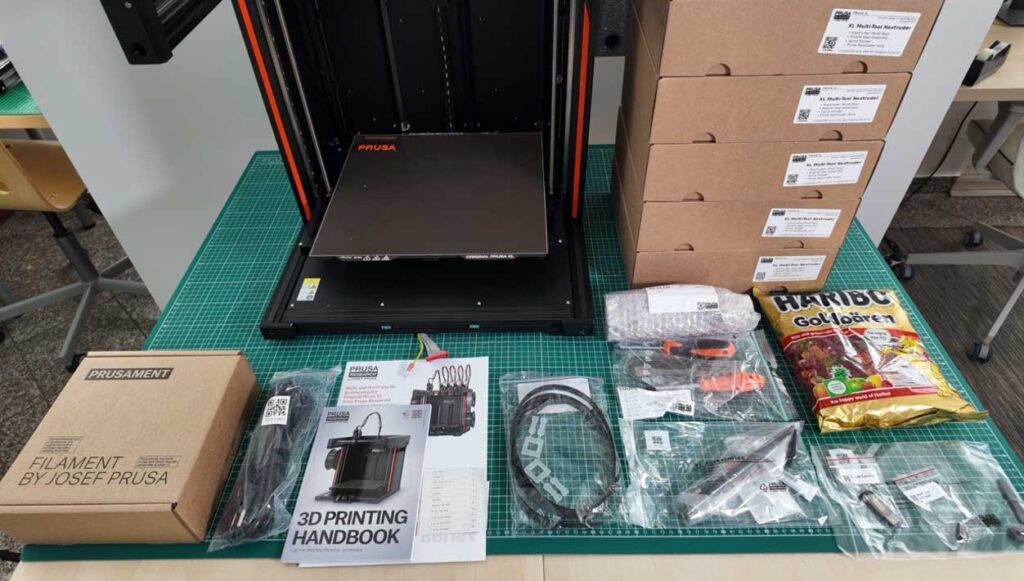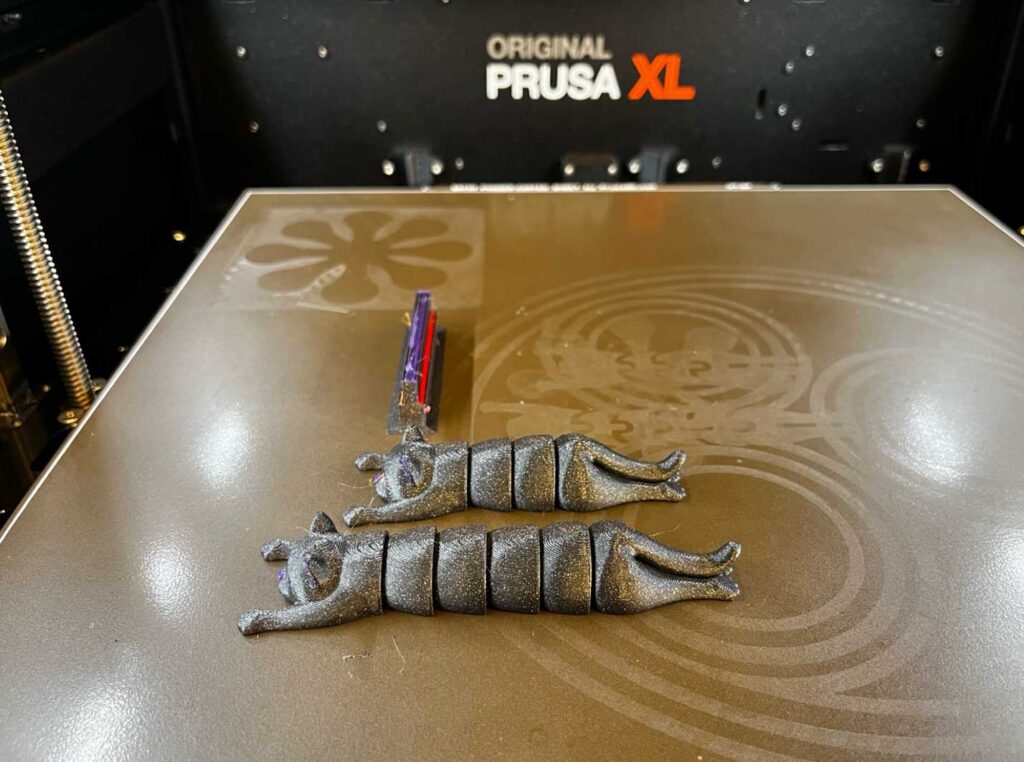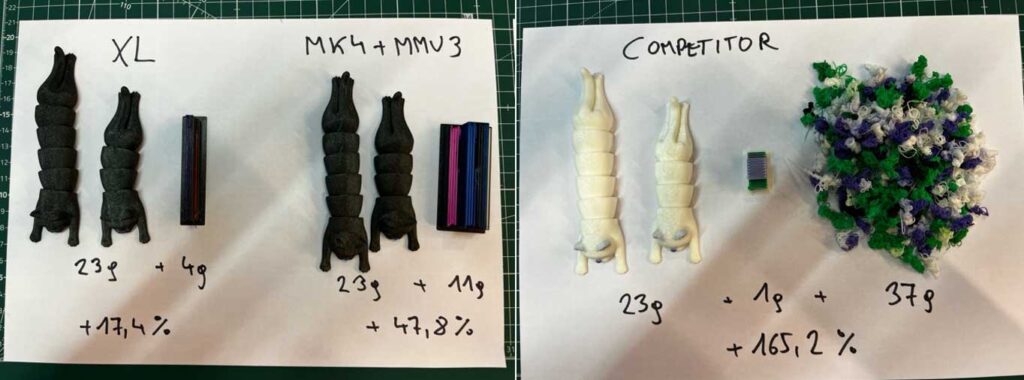The Original Prusa XL is the true flagship of Prusa Research, setting new standards in large-format multi-material printing with its five independent extruders in a Core-XY setup. Our test shows that the device is suitable for a target audience far beyond the circle of enthusiasts.
Now that affordable multi-material FDM printing has reached a certain level of technical maturity, the FDM market is increasingly focusing on mastering this discipline, offering a growing portfolio of solutions. With the introduction of Prusa’s MMU3, a reliable multi-material option became available in the proven i3 design from the Czech manufacturer, making printed objects more colorful and versatile.
Other manufacturers are also following this trend, offering standard-sized solutions as well as large-format printers that allow different filament feeds to a single extruder. Prusa, on the other hand, pursues a different, more promising concept with the XL: instead of scaling up the i3 format with a gantry structure (as with the MK4), the XL uses a stable Core-XY structure. This demonstrates Prusa’s mastery of the three most prominent printer architectures (including the cantilever structure on the Prusa Mini).
The key advantage of the XL, however, lies in its use of up to five independent extruders with their own hotends, which can be seamlessly swapped using a tool changer. This configuration offers significant advantages, which we will discuss in more detail below. As usual with Prusa, the XL can be ordered with one, two, or all five tool heads and can be upgraded at any time. This fits seamlessly into Prusa’s broad and flexible ecosystem, and it can be expected that future upgrade kits will keep the printer up to date.
There is also an optional enclosure for the XL that promises additional benefits, which we intend to review separately. With a build volume of 360 x 360 mm, the XL also offers enough space for projects that go far beyond the hobbyist realm.
Delivery and Setup
Our Original Prusa XL is delivered as “assembled,” but still requires attaching some sensitive, pre-assembled parts such as the display, Wi-Fi antenna, and the five extruders, which are packed separately and securely in the box. Assembly is essentially limited to connecting the display and cables, attaching the external Wi-Fi antenna, and the more complex installation of the five extruders. These steps are, as always with Prusa, excellently explained in many languages. Overall, assembly should take about an hour.
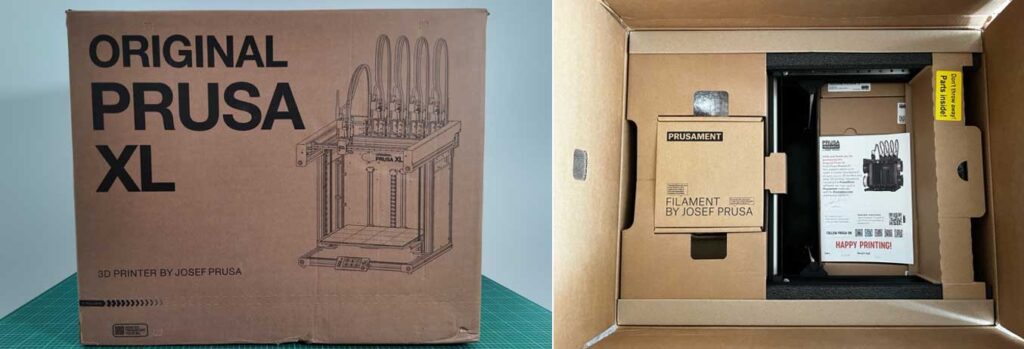

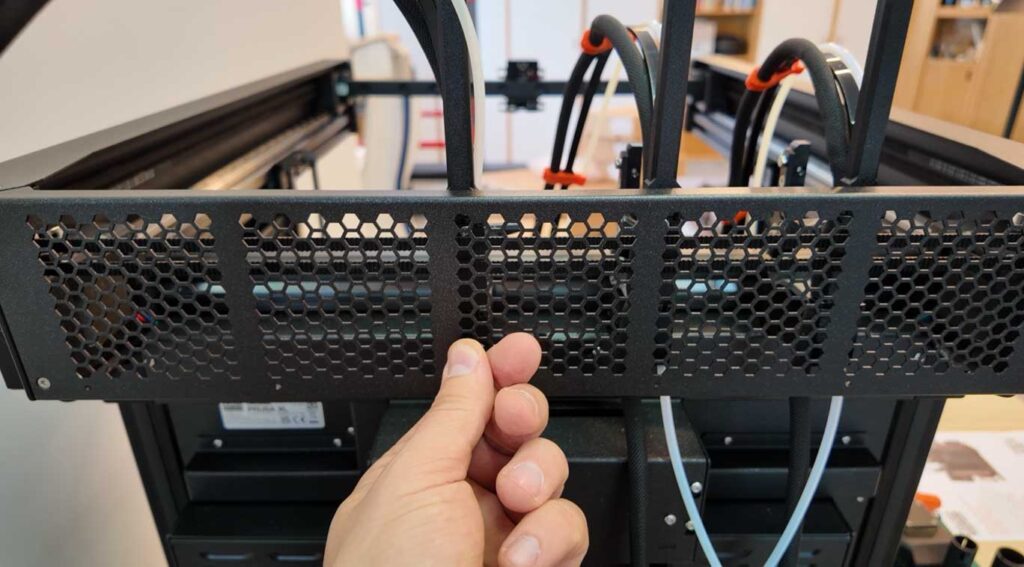
After the first power-up, the self-tests and calibration steps, which the device performs mostly automatically, take almost another hour. Although this seems long, it should be noted that five extruders need to be calibrated precisely here. After about two hours, you have a fully operational, powerful multi-material printer at your disposal. The control via the menu and touchscreen is typical for Prusa and requires no adjustment for experienced users.
Contents and First Impression
The Original Prusa XL includes, in addition to the five extruders, the Wi-Fi antenna, and the display, a complete toolset, a manual, a filament catalog, stickers, and an XL bag of Haribo gummy bears. A spool of Galaxy Black Prusament PLA and a USB stick with several print models are also included. The preferred software, PrusaSlicer, is available for free download.
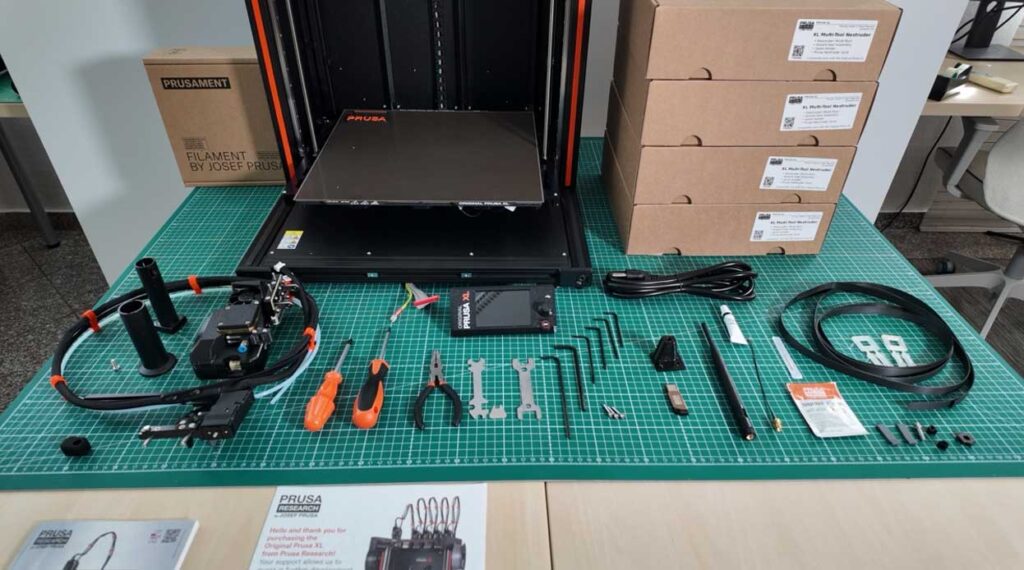
The design of the Prusa XL blends seamlessly into the typical Prusa design line. The machine, in the characteristic black and orange colors, made of steel, aluminum, and PETG-printed parts, looks extremely stable. The Bowden tubes protruding from the device give the printer a futuristic, almost alien-like look. LED strips mounted below the frame, as well as individual LEDs on each extruder, reinforce this impression while also providing practical lighting for the build area.
Features
The Prusa XL is a true multi-material 3D printing solution capable of processing up to five different filament types simultaneously. Each filament type has its own extruder and hotend, allowing not only the combination of different materials and colors but also the use of various hotends (pre-installed) flexibly depending on the need. The core of the machine is the tool changer, which can switch between the different extruders without wasting excessive filament.
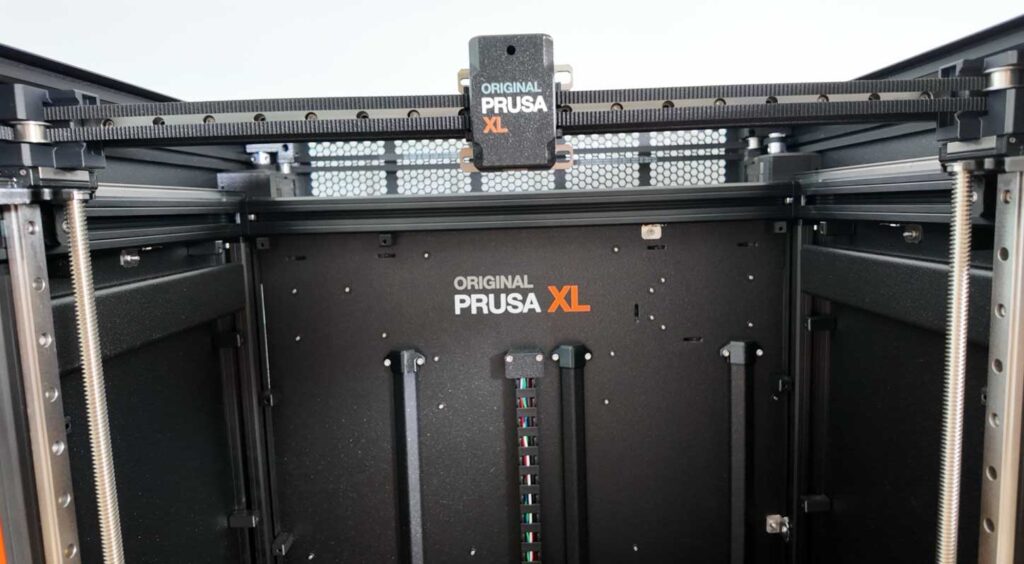
With its variable number of extruders, the printer is ideal for highly precise, multi-colored prints, the use of special support materials, or the combination of different materials in a single object.
A popular combination for support structures is PLA with PETG, as these materials only adhere slightly and can therefore be easily and cleanly removed. With the ability to process up to five materials simultaneously, Prusa surpasses many of its current competitors.
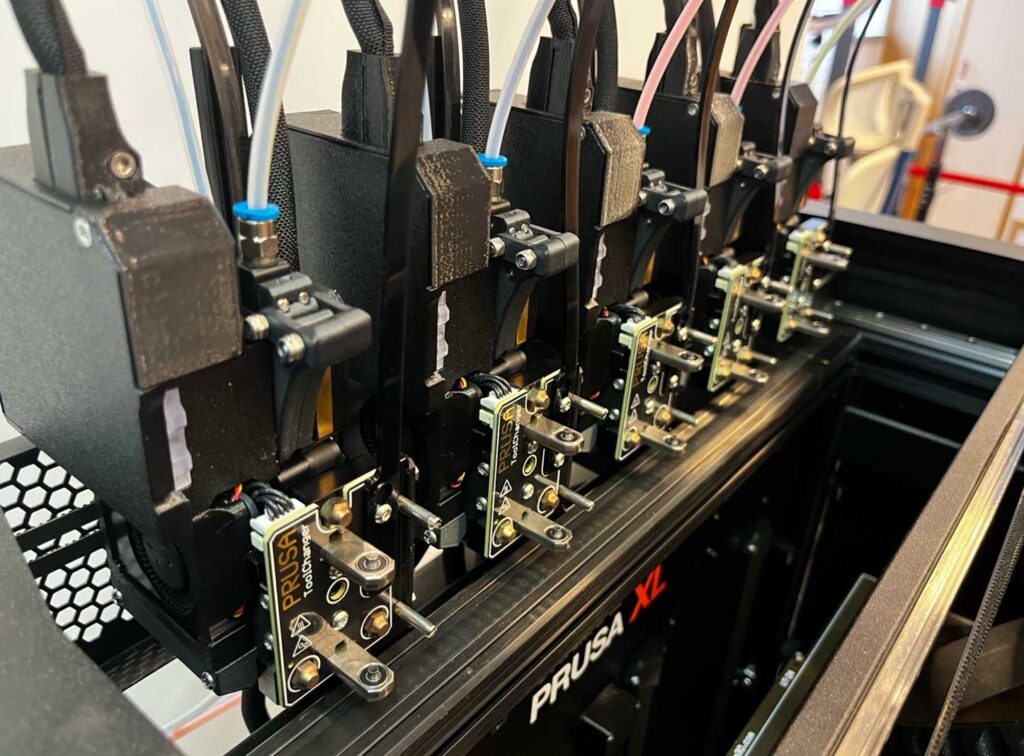
The firmware is based on Marlin but also integrates Input Shaping to improve print quality at higher speeds. Each extruder is equipped with its own acceleration sensor. Like with the MK4 models, Prusa has deliberately avoided focusing on maximum print speed to not compromise print quality. This decision positions the XL clearly for professional and industrial applications, where process stability and print quality take precedence over raw speed.
The heated bed of the XL consists of 16 individually controlled heating tiles, ensuring an even heat distribution. The printer also has integrated Wi-Fi with an external antenna, allowing secure control over the local network or via Prusa Connect.
Detailed Specifications
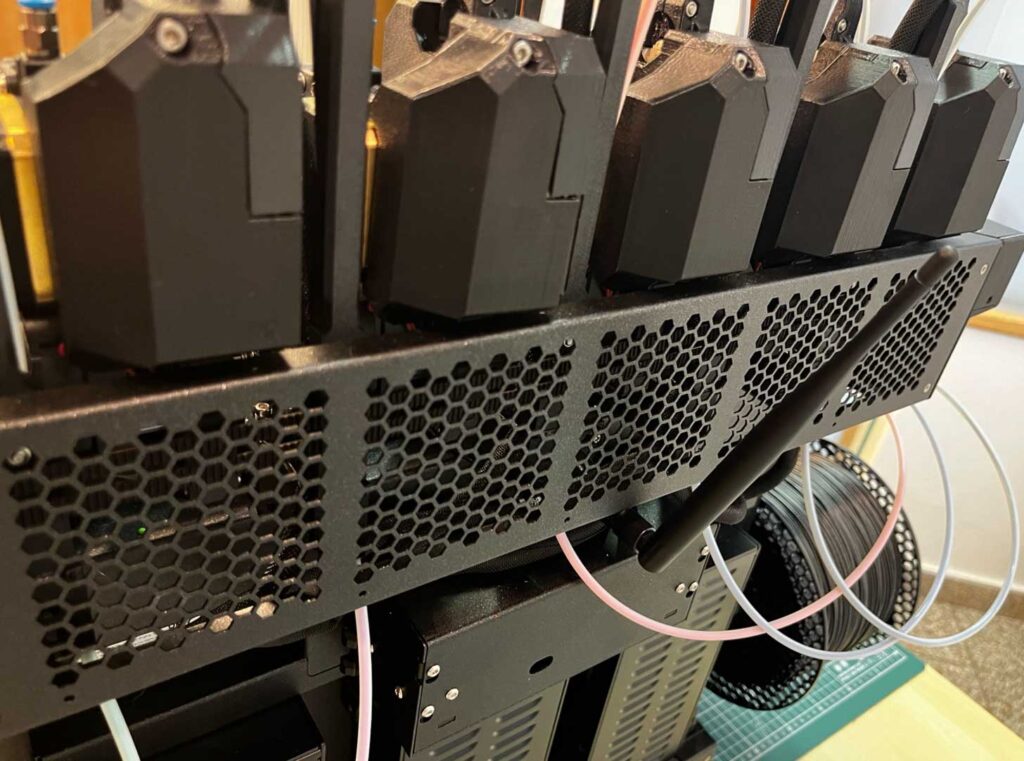
| Build volume | 360×360×360 mm (14.17″×14.17″×14.17″) |
| Filament diameter | 1.75 mm |
| Layer height | 0.05-0.30 mm |
| Printer dimensions (without spool) | 27.7 kg (single head) / 29.3 kg (dual head) / 33.7 kg (five heads), 700 mm (W) × 900 mm (H) × 720 mm (D), 27.5″×35.5″×28.5″, including side spool holders and separate top covers |
| Mainboard | Custom 32-bit xBuddy electronics with STM32 |
| Stepper motor drivers | Trinamic 2130 |
| Stepper motors | 1.8° |
| Extruder | Nextuder, Direct Drive, E3D V6 compatible (with custom adapter) |
| Extruder electronics | Custom breakout board for connecting fans, thermistors, and other components |
| Filament path | Filament cooler, Cemental hotend |
| Drive system | Nextdrive planetary gear system, 10:1 gear ratio |
| Maximum nozzle temperature | 300°C / 554°F |
| Maximum heated bed temperature | 120°C / 248°F |
| LCD screen | 5″ color touchscreen display |
| Connectivity | Optional ESP Wi-Fi module (included with the printer) |
| Print medium | USB stick / LAN / Internet via Prusa Connect |
| Advanced sensors | Filament sensor, load cell sensor, Power Panic, 4 high-precision thermistors (Original Semitec) + cartridge heater temperature sensors |
| Print surface | Segmented, heated magnetic plates with various print surface options |
| Bed calibration | Fully automatic bed leveling (only in the printable area) |
| Supported materials | PVA, PLA, PETG, Flex, PC, PP, CPE, PVB, and many more, including composite materials |
| Power supply | 240W, built-in, internal Delta PWM Power Panic HW |
| Power consumption | PLA consumption: 80W / ABS consumption: 120W |
Our Review
The Prusa XL works best with PrusaSlicer, which uses the familiar color painting feature from the MMU system. PrusaSlicer is free to use and compatible with many other 3D printers from different brands. Of course, the Prusa XL can also be used with other slicer programs if necessary.
For using the built-in Wi-Fi, Prusa Link and Prusa Connect are available. Prusa Link is a simple interface that connects the printer over the local network, allowing file uploads and control of basic functions. Prusa Connect, on the other hand, is a cloud-based, more comprehensive solution that offers full remote access to the printer.
Loading filament into the Prusa XL is very easy. The five spool holders can hold both standard 1-kg and 2-kg spools. In theory, the device can be equipped with up to 10 kg of filament. Each of the up to five tool heads has its own spool holder and is fed filament through a Bowden tube about 1.2 meters long. Since this is a direct-drive printer, the filament must be manually guided through the tube until the extruder gears grab it. However, the process is much simpler than with the MMU3.
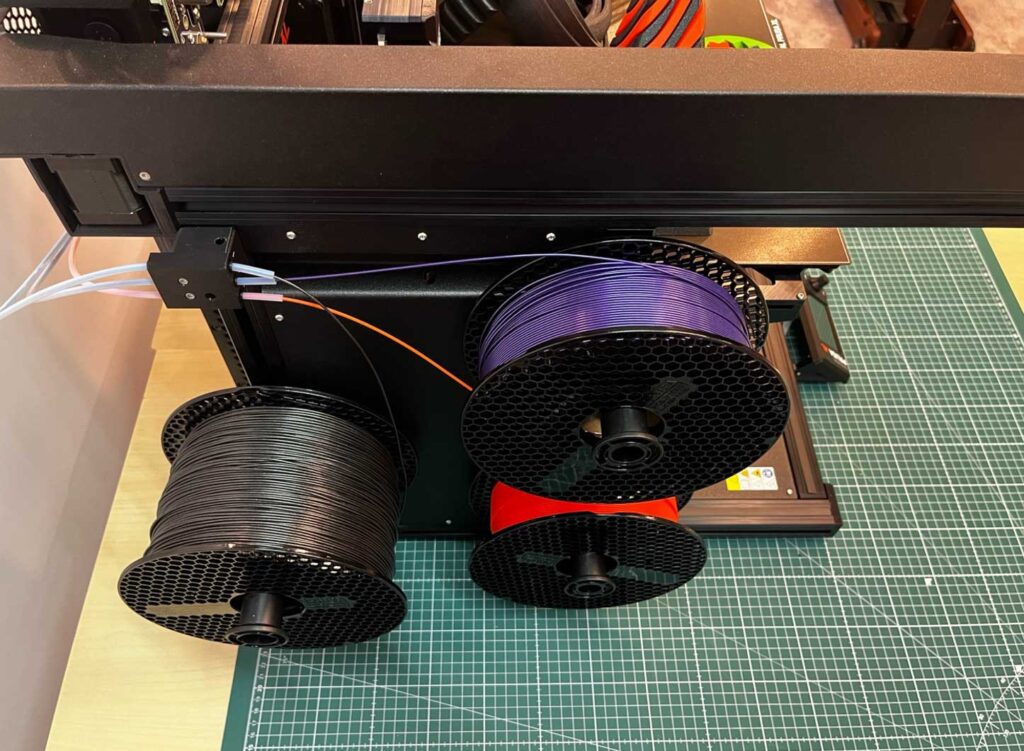
As with the MK4(s), the XL detects when new filament is inserted, asks for the material type, and adjusts the temperature automatically. The printer then pulls the filament into the hotend and checks if the color change was successful. If not, the filament is flushed further. For flexible materials like TPU, the Bowden tubes can cause unwanted friction resistance. In this case, the Bowden tubes can be removed from some or all extruders to process rubber-like materials smoothly. Using the “Spool Join” function, multiple or even all extruders can be loaded with the same filament. If the material on one spool runs out during the printing process, the device automatically switches to the next extruder without interrupting the print job. This function offers enormous flexibility and ensures that even large print jobs can be completed without material interruptions.

In our tests, the printer performed absolutely reliably and impressively clean, even with large objects. Particularly impressive was our test with multiple materials, which – as mentioned above – opens up numerous new application possibilities.
Unmatched Speed in Multi-Material Printing
Although the relative printing speed is expectedly lower than that of classic Klipper devices, the absolute print speed for multi-material applications significantly surpasses current competitors. This is primarily due to the professional tool changer, which minimizes the cleaning time for the extruder.
Another excellent advantage of the Prusa XL is the drastic reduction in filament waste during multi-colored prints. The Prusa MMU3 already impressed us with material-saving methods, but the XL takes this to another level. In a direct comparison of a four-material print, the XL outperforms its competitors not only in terms of speed but also requires only about 17% material waste in our test print, whereas the MK4 and MMU3 combination produces around 48% waste, and alternative providers consume up to 165% more material.
Our Conclusion
The price of the Prusa XL starts at €2,099 with one extruder. From our perspective, however, at least the version with two extruders (starting at €2,599) is worth considering, and ideally, the five-extruder version, available from €3,699 (partially assembled) or €4,199 (fully assembled) like our test model. The price may seem high compared to some competitors in the consumer segment, and this is partly due to Prusa’s premium strategy. However, the Prusa XL, with its features, efficiency, and quality output, positions itself clearly in the realm of professional applications and is even comparatively aggressively priced for this sector. For hobbyists or occasional users, of course, there are cheaper alternatives, such as the Prusa MK4s with MMU3, which is also a good choice for less intensive applications.
The time and material savings offered by the XL in multi-material printing will quickly pay off, even with medium usage. In addition, there are the usual Prusa advantages: excellent spare parts service, comprehensive instructions, simple upgrade options, and the ability to keep the device up to date with upgrades. Furthermore, the XL fits perfectly into the Prusa ecosystem.
Subscribe to our Newsletter
3DPresso is a weekly newsletter that links to the most exciting global stories from the 3D printing and additive manufacturing industry.




